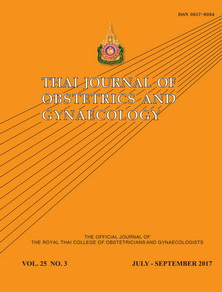Effect of Maternal Body Mass Index on Serum Magnesium Level in Pregnant Women with Preeclampsia at Maharat Nakhon Ratchasima Hospital
Main Article Content
Abstract
Objectives: To compare serum magnesium level in pregnant women with severe preeclampsia between normal body mass index (BMI) and high BMI after receiving magnesium sulfate at Maharat Nakhon Ratchasima Hospital.
Materials and Methods: The prospective study of 52 pregnant women with severe preeclampsia who received magnesium sulfate for preventing seizure at Maharat Nakhon Ratchasima Hospital during May 2015 to November 2015. The patients were pregnant women with severe preeclampsia who were given 4 grams and then a 1 gram per hour as a maintenance dose. Serum magnesium level was monitored every 4 hours during magnesium sulfate infusion and level was considered subtherapeutic if it was less than 4.8 mg/dL, therapeutic from 4.8 – 8.4 mg/dL and supratherapeutic at 8.5 mg/dL or more. The magnesium sulfate infusion was adjusted after delivery to maintain therapeutic serum magnesium level. The first serum magnesium level and the first one after delivery were collected to compare between two groups of patients divided by the body mass index (BMI): normal BMI (BMI < 25 kg/m2), and high BMI (BMI ≥ 25 kg/m2).
Results: A total of 119 patients were diagnosed with severe preeclampsia during the period of study. There were 52 women who met the inclusion criteria. Normal BMI group was proved to have a higher chance of therapeutic serum magnesium level by both records significantly (RR 10.0, 95%CI 1.38-72.61 and 4.33, 95%CI 1.39 – 13.44) (P = 0.005, 0.0027 respectively). After delivery, the high BMI group tends to have higher dose of magnesium sulfate infusion to maintain therapeutic serum magnesium level.
Conclusion: Body weight of the pregnant woman has effected serum magnesium level. The BMI of more than 25 kg/m2 tends to get subtherapeutic serum magnesium level. However the study has been found no seizure in patients with subtherapeutic serum magnesium level in both groups. No case of supratherapeutic serum magnesium level was found during magnesium sulfate infusion 1 gram per hour.
Article Details
References
2. Cunningham FG, Leveno KJ, Bloom SL, Hauth JC, Rouse DJ, Spong CY, et al. Hypertensive disorders in pregnancy. Williams Obstetrics. 24th ed. New York: McGraw – Hill 2014:1507-612.
3. Maternal and Child Health. RTCOG Guideline: Management of Preeclampsia and Eclampsia; March 2012:8-17.
4. American College of Obstetricians and Gynecologists: Task Force on Hypertension in Pregnancy. Hypertension in pregnancy. Report of the American College of Obstetricians and Gynecologists’ Task Force on Hypertension in Pregnancy. Obstet Gynecol 2013;122:1122-31.
5. Kitiyodom S. Eclampsia in Maharat Nakhon Ratchasima hospital. Med J Srisaket Surin Buriram Hosp 2014;29:129-38.
6. Quamme GA, Dirks JH. Magnesium metabolism. In: Narin RG, ed. Clinical disorders of fluid and electrolyte metabolism. 5th ed. New York: McGraw Hill 1994:373.
7. Centers for Disease Control and Prevention. Division of Nutrition, Physical Activity, and Obesity [Internet]. 2015 [cited 2015 May 15]. Available from: www.cdc.gov/ healthyweight/assessing/.
8. Tudela CM, McIntire DD, Alexander JM. Effect of maternal body mass index on serum magnesium levels given for seizure prophylaxis. Obstet Gynecol 2013;121:314-20.
9. Dayicioglu V, Sahinoglu Z, Kol E, Kucukbas M. The use of standard dose of magnesium sulfate in prophylaxis of eclamptic seizure: Do body mass index alterations have any effect on success?. Hypertens Pregnancy 2003;22:257-65.


